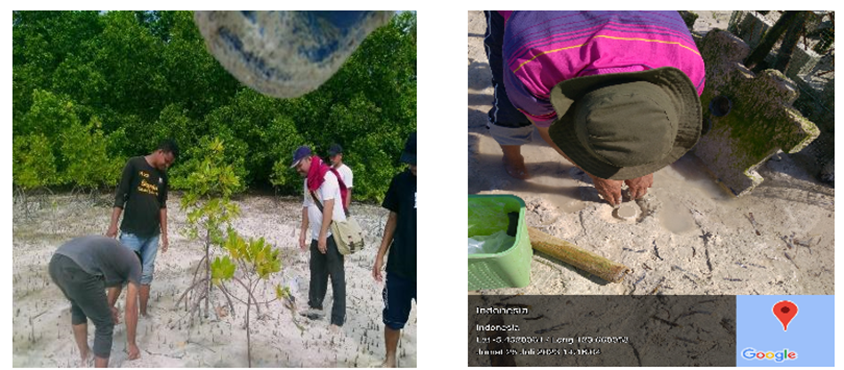Wakatobi Mangrove Trap 1st Generation: A Small-Scale Prototype of Mangrove Biota Trapping Technology for Wakatobi Small-Islands, Southeast Sulawesi
Main Article Content
Abstract
Mangrove ecosystems have forest functions and benefits as a nursery zone for fisheries biota, protecting coastal abrasion, carbon sinks, and supporting nutrient content for aquatic health. Unfortunately, the area of this forest is decreasing, so conservation efforts are needed. Mangrove forests in Wakatobi Regency are a very important resource for coastal areas and small islands and should be preserved and continuously developed, along with other resources. Mangrove forest conservation efforts have become the main concern of the parties. However, planting and rehabilitation efforts are still an obstacle due to very slow growth and even death. Several cases were found where mangrove propagule planting on Wangi-Wangi Island Beach died in a short time. The aim of the research is to design a prototype or simple technology that is useful for trapping sediment and reducing the influence of waves at the beginning of propagule planting and when mangrove saplings have begun to grow and survive at the age of about 1.5 to 3 years. This research is included in quantitatively applied research in the form of a simple structural product that is then installed on Melaione Matahora Beach and Liya Togo Beach. The results obtained are the design (prototype) of a mangrove trap with a concrete structure measuring as 1 m x 0,5 m x 0,5 m with a shape similar to a puzzle box, each side of which locks together. Wakatobi mangrove trap box contains a mixture of mangrove leaf litter, seagrass litter, aggregate humus soil, and sandy soil, which is then planted with propagules of mangrove. This research lasted approximately 1 (one) year more, and the mangrove-planted seedlings grew well, although seedlings planted on Melaione Matahora Beach initially died due to moss pests, but after repairing the prototype to the 1st generation model, the propagule grew well and survival until now.
Downloads
Article Details

This work is licensed under a Creative Commons Attribution 4.0 International License.
Allow anyone to modify, improve, and make derivative works, even for commercial purposes, as long as they credit to you for the original work.
References
A. Ramadhan, L. Lindawati, and N. Kurniasari, “NILAI EKONOMI EKOSISTEM TERUMBU KARANG DI KABUPATEN WAKATOBI,” J. Sos. Ekon. Kelaut. dan Perikan., vol. 11, no. 2, p. 133, Mar. 2017, doi: 10.15578/jsekp.v11i2.3834.
P. J. Mous et al., “Policy needs to improve marine capture fisheries management and to define a role for marine protected areas in Indonesia The World Wide Fund for Nature Indonesia-Marine Program, Jakarta, Indonesia,” Improv. Fish. Manag. POLICIES Indones., vol. 12, no. 1, pp. 259–268, Dec. 2005, Accessed: Aug. 25, 2023. [Online]. Available: https://d1wqtxts1xzle7.cloudfront.net/47955971/Policy_needs_to_improve_marine_capture_f20160810-6219-3k1573-libre.pdf?1470865509=&response-content-disposition=inline%3B+filename%3DPolicy_needs_to_improve_marine_capture_f.pdf&Expires=1692928592&Signature=PJ2VxU~pFIzV4jHINkAPGb~MoMY4-0ODAJn3Mfy4eUf9NkCpr6R1chk6-tj-B1vcEYkc3YmPNNXhLbnXKGjs5sAXUul6NW5tBvhIlUTNIbCrDwydSIkC9PJ09i1XqWGWxI0ZuCaqRBmuZITU6AwlIE0BjTtJb5ofUmX-0Klf2nycHAIJ4BL2qmCmTpqWgGXDY08jO50slMp6G1cGDXXM0NVblJ4YrxinoM8yx9YXrsACP7fy-g5yAGiDVYJacvwtzJOxO8-CliUgjcgUXtv9WAgEav3KgptqgVNItvT8Ja153hMdITEVIRVk9gWdgWlJuf5RFILCueWwJ-iZx3wWOQ__&Key-Pair-Id=APKAJLOHF5GGSLRBV4ZA
J. H. Fikri Firmansyah, Adib Mustofa, Estradivari, Andrian Damora, Christian Handayani, Gabby Ahmadia, Satu Dekade Pengelolaan Taman Nasional Wakatobi: Keberhasilan dan Tantangan Konservasi Laut, 1st ed., vol. 1. Jakarta: WWF Indonesia, 2017. [Online]. Available: https://www.researchgate.net/publication/322853835
A. J. Wahyudi and S. S. Nurul Dhewani Mirah Sjafrie, Deny Sutisna, Ucu Yani Arbi, Selvia Oktaviyani, Putri Sapira Ibrahim, Beben Hidayat, Deni Sutansyah, “LEGASI COREMAP Hasil, Dampak, serta Proyeksi Program Pemantauan dan Riset Ekosistem Laut Indonesia REVEALS COREMAP LEGACY,” Jakarta, Jun. 2022. Accessed: Aug. 25, 2023. [Online]. Available: https://penerbit.brin.go.id/press/catalog/download/560/427/15287?inline=1
Etty Silviana Wahyuningrum and A. S. Max Rudolf Muskananfola, “Hubungan Tekstur Sedimen, Bahan Organik dengan Kelimpahan Biota Makrozoobentos di Perairan Delta Wulan Kabupaten Demak,” Manag. Aquat. Resour., vol. 5, no. 1, pp. 46–51, May 2016, doi: https://doi.org/10.14710/marj.v5i1.10667.
N. S. Agusrinal and Lilik Budi Prasetyo, “TINGKAT DEGRADASI EKOSISTEM MANGROVE DI PULAU KALEDUPA, TAMAN NASIONAL WAKATOBI Mangrove Ecosystem Degradation Level in Kaledupa Island, Wakatobi National Park,” J. Silvikultur Trop., vol. 06, no. 3, pp. 139–147, 2015.
Zona Sultra, “Hari Mangrove Sedunia, BTNW Bersama Bupati Wakatobi Tanam 2.021 Bibit Mangrove,” https://zonasultra.id/hari-mangrove-sedunia-btnw-bersama-bupati-wakatobi-tanam-2-021-bibit-mangrove.html, Kendari, pp. 1–2, Jul. 28, 2021. Accessed: Aug. 25, 2023. [Online]. Available: https://zonasultra.id/hari-mangrove-sedunia-btnw-bersama-bupati-wakatobi-tanam-2-021-bibit-mangrove.html
Rignolda Djamaluddin, Mangrove Biologi, Ekologi, Rehabilitasi, dan Konservasi, 1st ed., vol. 1. Manado: Unsrat Press, 2018. Accessed: Aug. 25, 2023. [Online]. Available: http://repo.unsrat.ac.id/2658/1/Mangrove_Biologi_Ekologi_Rehabilitasi_Konservasi_2018.pdf
Pramudji Sasatrosuwondo, “Mangrove Sulit Tumbuh Di Pantai Terbuka,” https://www.ekuatorial.com/2010/11/mangrove-sulit-tumbuh-di-pantai-terbuka/, Nov. 01, 2010.
Rokhmin Dahuri and S. P. G. M. . S. Jacub Rais, Pengelolaan Sumber Daya Wilayah Pesisir dan Lautan Secara Terpadu, 1st ed., vol. I. Jakarta: PT Pradnya Paramita, 1996. Accessed: Aug. 26, 2023. [Online]. Available: https://www.google.com/search?q=pengelolaan+sumber+daya+wilayah+pesisir+dan+lautan+secara+terpadu&tbm=isch&ved=2ahUKEwj0gpSLqfmAAxWHmmMGHTziAnYQ2-cCegQIABAA&oq=pengelolaan+sumber+daya+wilayah+pesisir+dan+lautan+secara+terpadu&gs_lcp=CgNpbWcQAzIHCAAQGBCABFDaGVjmNmC3PWgAcAB4AIABqwGIAZEEkgEDMC40mAEAoAEBqgELZ3dzLXdpei1pbWfAAQE&sclient=img&ei=MWnpZLSmNIe1juMPvMSLsAc&bih=702&biw=795#imgrc=JXVEUC1d5h6rZM
M. Firmansyah, R. Alamsyah, and Ade Putra, “Laju Dekomposisi Serasah Daun Mangrove Di Kelurahan Lappa Kecamatan Sinjai Kabupaten Sinjai,” Sinjai, Jun. 2020. [Online]. Available: https://media.neliti.com/media/publications/344724-laju-dekomposisi-serasah-daun-mangrove-d-863f9fa8.pdf
Zamroni and I. S. Yuliadi Rohyani, “Litterfall production of mangrove forest in the beach waters of Sepi Bay, West Lombok,” Biodiversitas J. Biol. Divers., vol. 9, no. 4, Sep. 2008, doi: 10.13057/biodiv/d090409.

